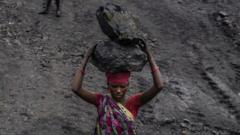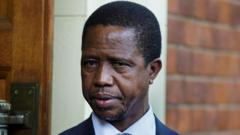This unique venture demonstrates how cryptocurrency can leverage renewable energy for profit and community benefit, despite facing challenges ahead.
**Bitcoin's Green Revolution: Crypto Mining in Zambia's Remote Wilderness**

**Bitcoin's Green Revolution: Crypto Mining in Zambia's Remote Wilderness**
In Zambia, a bitcoin mine powered by hydro-electricity is transforming lives and reshaping the local economy.
The roar of the Zambezi River echoes through the lush Zambian bush, a powerful reminder of nature's energy as it tumbles relentlessly over the rocks. However, there’s a different sound for locals – the persistent whirr of a bitcoin mine, nestled in the heart of wilderness. "It's the sound of money!” exclaims Phillip Walton, beaming as he oversees a makeshift operation comprising 120 computers filtering through intricate calculations required to validate bitcoin transactions.
Situated on Zambia's far north-western border with the Democratic Republic of Congo, this bitcoin operation is particularly distinctive. The essence of its existence is wedged in its proximity to the mighty river; the mine is directly connected to a hydro-electric power plant that channels the Zambezi's current through large turbines, generating consistent and clean electricity.
This setup has drawn Phillip’s company, Gridless, to transport shipping containers filled with fragile bitcoin mining gear, all to excavate profit in one of the most remote regions, taking a grueling 14-hour journey from the nearest major city. Each computer now nets about $5 a day, a sum that fluctuates with the erratic valuation of bitcoin.
“By partnering with the local power company, our mining economics drastically improved," explains Phillip, who monitors the volatile value of bitcoin on his smartwatch. Presently valued around $80,000 a coin, the operation remains financially viable even when bitcoin prices dip due to the plant's inexpensive electricity and shared revenue model with the energy provider.
The Zengamina hydro-power plant, operational since 2007 thanks to generous charitable donations surpassing $3 million, generates energy not just for the bitcoin mine but also to power around 15,000 local residents. Daniel Rea, who manages the site, highlights that previously the plant suffered from low energy consumption rates, causing revenue issues. The bitcoin mine has transformed the landscape, significantly increasing the plant’s revenue – it now constitutes roughly 30% of their total earnings, helping to maintain lower electricity costs for local residents.
For townsfolk, many might remain unaware of the digital mining occurring nearby; daily life continues as they navigate the sparsely populated streets of Zengamina. Damian, a barber, reflects on how life has changed since gaining electricity. His shop, brightly lit with lights and a TV, attracts the youth, symbolizing the shift from darkness to vibrant community engagement.
Electricity, once a rare commodity, has revolutionized the lives of residents, making communication and access to entertainment a reality. Tumba and Lucy Machayi, local youths, recount their past experiences of living without electricity, as they now engage with the world through their mobile devices, symbolizing a leap in the standard of living that much of the community showcases.
Despite the positive changes, the bitcoin mine’s future remains uncertain. Plans for expansion by the Zengamina Hydro expect to tap into the national grid soon, meaning the previously harvested energy could soon be sold back to the grid, diminishing profitability for the bitcoin operation. Nevertheless, Phillip's team approaches this inevitability with optimism, proud of their impact during their tenure there and the profits they've amassed.
Gridless is now exploring further ambitions, aiming to construct their own hydro-plants designed to mine bitcoin while simultaneously providing electricity to underserved rural populations. Co-founder Janet Maingi elaborates on how Africa has untapped hydro potential that they intend to harness.
However, challenges persist. Some authorities view bitcoin mining skeptically due to its perceived drain on public resources, and the company often confronts resistance. Gridless insists selling energy to the highest bidder ensures that local communities remain the ultimate beneficiaries.
The tension between environmental sustainability and economic opportunity looms large, given that bitcoin mining can consume energy equivalent to a small country. Yet, there is a gradual transition toward sustainable methods, as evidenced in Zengamina's model. Such initiatives illuminate how this modern industry can foster more than mere pixels but rather generate tangible social enhancement and economic opportunities for local communities.





















